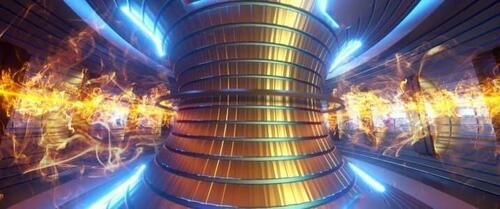
Authored by Tsvetana Paraskova via OilPrice.com,
-
Mayonnaise exhibits similar properties to plasma, aiding fusion research.
-
Scientists are studying the condiment to understand the behavior of plasma in fusion reactions.
-
Breakthroughs in fusion research, including recent experiments, offer hope for future clean energy solutions.
The most common of condiments could help researchers better understand the physics behind one of the most difficult and sought-after scientific feats—making nuclear fusion a reality.
When compressed and heated, mayonnaise exhibits some characteristics similar to the various states of plasma in a hypothetical nuclear fusion reaction, scientists have found.
So, the common condiment could become an ingredient in solving one of humanity’s longest-standing dreams—achieving nuclear fusion.
Fusion is the natural process that heats the Sun and all other stars, in which a huge amount of energy is produced by the fusion of light atoms, such as those in hydrogen, into heavier elements like helium.
Nuclear fusion has long been considered the answer to zero-emission by-product-free energy generation. However, no one has cracked the nuclear fusion code yet because of the challenges associated with the environment in which the process could take place.
Inertial confinement fusion, the process that starts a nuclear fusion reaction, has several challenges to overcome. One of these is the instability of the plasma state which results from rapid compression and heating of capsules filled with isotopes of hydrogen.
The so-called Rayleigh-Taylor instability that occurs is the interpenetration of materials when fluids with different densities collide.
And here comes mayonnaise, which has become a key ingredient to the ongoing research on the phases of Rayleigh-Taylor instability, researchers at Lehigh University say.
“We’re still working on the same problem, which is the structural integrity of fusion capsules used in inertial confinement fusion, and Hellmann’s Real Mayonnaise is still helping us in the search for solutions,” said Arindam Banerjee, the Paul B. Reinhold Professor of Mechanical Engineering and Mechanics at Lehigh University and Chair of the MEM department in the P.C. Rossin College of Engineering and Applied Science.
“We use mayonnaise because it behaves like a solid, but when subjected to a pressure gradient, it starts to flow,” he says.
Banerjee and team have been studying the properties of mayonnaise in relation to plasma characteristics for at least half a decade.
Back in 2019, they published their first paper on the topic called “Rayleigh-Taylor-instability experiments with elastic-plastic material,” in the scientific journal Physical Review E.
The team has continued experiments in mayonnaise and published their latest paper on the topic, “Transition to plastic regime for Rayleigh-Taylor instability in soft solids,” earlier this year.
In the latest paper and experiments, the scientists are “trying to enhance the predictability of what would happen with those molten, high-temperature, high-pressure plasma capsules with these analog experiments of using mayonnaise in a rotating wheel,” Banerjee said.
“We’re another cog in this giant wheel of researchers,” he said, commenting on the cohort of scientists working to make fusion a reality.
“And we’re all working towards making inertial fusion cheaper and therefore, attainable.”
In nuclear fusion efforts, recent breakthroughs in the U.S. have encouraged more R&D efforts in America and elsewhere.
At the end of 2022, Lawrence Livermore National Laboratory made history, demonstrating fusion ignition for the first time in a laboratory setting—an achievement six decades in the making. The fusion energy released was greater than the laser energy delivered to start the reaction, passing the threshold of ignition.
LLNL’s National Ignition Facility (NIF) has so far achieved ignition four times since 2022, giving hope to scientists that fusion for energy may not be only a pipe dream as it has been for decades.
China is also catching up on the race for fusion technology.
It is building a Comprehensive Research Facility for Fusion Technology (CRAFT) in Hefei—a project in which key components for fusion energy reactors are developed and tested. The facility is expected to be finished in 2025.
The U.S. has several large private fusion companies, including Commonwealth Fusion Systems (CFS), which has just signed an agreement with the U.S. Department of Energy worth $15 million to meet research and development goals leading to commercial fusion power.
The incentives in the U.S. Administration’s Milestone program to support fusion energy “can help us keep moving step by step toward our goal of building our first fusion power plant by the early 2030s,” CFS chief executive and co-founder Bob Mumgaard said in June.
Authored by Tsvetana Paraskova via OilPrice.com,
-
Mayonnaise exhibits similar properties to plasma, aiding fusion research.
-
Scientists are studying the condiment to understand the behavior of plasma in fusion reactions.
-
Breakthroughs in fusion research, including recent experiments, offer hope for future clean energy solutions.
The most common of condiments could help researchers better understand the physics behind one of the most difficult and sought-after scientific feats—making nuclear fusion a reality.
When compressed and heated, mayonnaise exhibits some characteristics similar to the various states of plasma in a hypothetical nuclear fusion reaction, scientists have found.
So, the common condiment could become an ingredient in solving one of humanity’s longest-standing dreams—achieving nuclear fusion.
Fusion is the natural process that heats the Sun and all other stars, in which a huge amount of energy is produced by the fusion of light atoms, such as those in hydrogen, into heavier elements like helium.
Nuclear fusion has long been considered the answer to zero-emission by-product-free energy generation. However, no one has cracked the nuclear fusion code yet because of the challenges associated with the environment in which the process could take place.
Inertial confinement fusion, the process that starts a nuclear fusion reaction, has several challenges to overcome. One of these is the instability of the plasma state which results from rapid compression and heating of capsules filled with isotopes of hydrogen.
The so-called Rayleigh-Taylor instability that occurs is the interpenetration of materials when fluids with different densities collide.
And here comes mayonnaise, which has become a key ingredient to the ongoing research on the phases of Rayleigh-Taylor instability, researchers at Lehigh University say.
“We’re still working on the same problem, which is the structural integrity of fusion capsules used in inertial confinement fusion, and Hellmann’s Real Mayonnaise is still helping us in the search for solutions,” said Arindam Banerjee, the Paul B. Reinhold Professor of Mechanical Engineering and Mechanics at Lehigh University and Chair of the MEM department in the P.C. Rossin College of Engineering and Applied Science.
“We use mayonnaise because it behaves like a solid, but when subjected to a pressure gradient, it starts to flow,” he says.
Banerjee and team have been studying the properties of mayonnaise in relation to plasma characteristics for at least half a decade.
Back in 2019, they published their first paper on the topic called “Rayleigh-Taylor-instability experiments with elastic-plastic material,” in the scientific journal Physical Review E.
The team has continued experiments in mayonnaise and published their latest paper on the topic, “Transition to plastic regime for Rayleigh-Taylor instability in soft solids,” earlier this year.
In the latest paper and experiments, the scientists are “trying to enhance the predictability of what would happen with those molten, high-temperature, high-pressure plasma capsules with these analog experiments of using mayonnaise in a rotating wheel,” Banerjee said.
“We’re another cog in this giant wheel of researchers,” he said, commenting on the cohort of scientists working to make fusion a reality.
“And we’re all working towards making inertial fusion cheaper and therefore, attainable.”
In nuclear fusion efforts, recent breakthroughs in the U.S. have encouraged more R&D efforts in America and elsewhere.
At the end of 2022, Lawrence Livermore National Laboratory made history, demonstrating fusion ignition for the first time in a laboratory setting—an achievement six decades in the making. The fusion energy released was greater than the laser energy delivered to start the reaction, passing the threshold of ignition.
LLNL’s National Ignition Facility (NIF) has so far achieved ignition four times since 2022, giving hope to scientists that fusion for energy may not be only a pipe dream as it has been for decades.
China is also catching up on the race for fusion technology.
It is building a Comprehensive Research Facility for Fusion Technology (CRAFT) in Hefei—a project in which key components for fusion energy reactors are developed and tested. The facility is expected to be finished in 2025.
The U.S. has several large private fusion companies, including Commonwealth Fusion Systems (CFS), which has just signed an agreement with the U.S. Department of Energy worth $15 million to meet research and development goals leading to commercial fusion power.
The incentives in the U.S. Administration’s Milestone program to support fusion energy “can help us keep moving step by step toward our goal of building our first fusion power plant by the early 2030s,” CFS chief executive and co-founder Bob Mumgaard said in June.
Loading…





